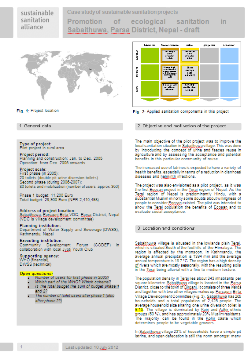Promotion of ecological sanitation, Sabaithuwa, Parsa District, Nepal (draft)
Heijnen, M., Heijnen, H., Zandee, M. (2012)

Published in: 2012
Publisher:
Sustainable Sanitation Alliance (SuSanA)
Author:
Heijnen, M., Heijnen, H., Zandee, M.
Uploaded by:
SuSanA secretariat
Partner profile:
common upload
13548 Views
354 Downloads
Location of library entry
Content - Summary
The case study describes a 2 phased pilot project initiative in the village of Sabaithuwa in the Parsa District in Nepal. The pilot project promoted ecological sanitation with the main objective to improve the local sanitation situation in Sabaithuwa village. The concept of urine and faeces reuse in agriculture was introduced to the community. It was planned to assess the acceptance and potential benefits in this particular community of reuse, but there was little documentation on this aspect. The project was planned by the Department of Water Supply and Sewerage (DWSS), Kathmandu, Nepal and executed by the Community Development Forum (CODEF) in collaboration with local Jyoti Youth Club with the support from WHO (financial) and DWSS (technical). The total budget for this project was 25,900 Euro (NPR 2,410,498).
The minimum criteria for selection of households for this project were: possession of agricultural land; acceptance to handle decomposed manure; and willingness to apply human manure on agricultural fields. As a consequence, the first Ecosan adopters, who received toilets for their private use, were comparatively rich people in the community, as they already owned land. Since those first toilets were 100% subsidised, the applicability of the model with lower subsidies and for poorer households will have to be proven. The subsidy and the possibility to use urine as fertiliser were the main motivation to build Ecosan toilets.
A pour-flush urine-diversion toilet was designed particularly for Terai, in which urine is collected separately and the human faeces are simply disposed alternatively in twin pits lined with concrete rings. The technology chosen was deemed to be a low-cost option, since the adoption of dehydration technology would require elevated chambers due to the high ground water table, which in turn implied in higher construction costs. The basic design of an Indian Sulabh pour flush latrine with two external pits was used, and modified for urine diversion by the local community themselves. Although the initial vision of the pilot project included safe reuse of dried faeces, the main focus of this project has been the reuse of urine. Urine is collected, stored in 20 or 30-L jerricans, diluted with water and then used without further treatment for all types of vegetables. Construction of the substructure including two storage pits, slab, urine-diversion pan and all connections cost approximately NPR 6,000 (€ 65). For the superstructure, the use of local materials is recommended. The complete construction of the substructure and a brick and mortar superstructure cost about € 110.
The owners are responsible for the maintenance or repair works. Due to the use of cement in the early pans, cleaning was found to be difficult. Almost all owners of a UD latrine are quite satisfied. A lack of handwashing stations near the UD latrines was noticed and also needs to be addressed in the near future. Though the long term project aim was to increase the sanitation coverage in the village to 100%, this has proven to be too ambitious. The process is hindered by financial restrictions as well as cultural or religious reservations or a lack of information about (ecological) sanitation issues. Even if the demand is high, many people cannot afford to purchase and to construct an appropriate latrine. From the economical point of view, the pilot project experience is not representative for the chances of a large scale adaptation of ecosan due to the high subsidies for the first latrines.
There are still a number of open questions at the end of each subsection, so please treat this version as a draft. If you are able to contribute you can discuss these questions or other related to the case study on the SuSanA forum follow the link below.
Bibliographic information
Heijnen, M., Heijnen, H., Zandee, M. (2012). Promotion of ecological sanitation, Sabaithuwa, Parsa District, Nepal (draft). Sustainable Sanitation Alliance (SuSanA)
Filter tags
Case studies in SuSanA template East Asia & Pacific English Rural Urine Urine diversion dehydration toilets (UDDTs)















